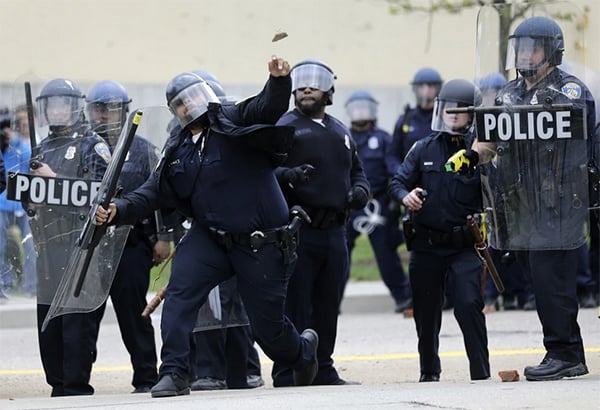
As Baltimore continues to be rocked by protests following the death of 25-year-old Freddie Gray, an unarmed African American man who died April 19 due to injuries sustained while in police custody, the Baltimore City Paper reports that its photo editor, J.M. Giordano, was beaten by the police while covering the story.
Saturday’s protests were largely peaceful, with rival gang members standing side-by-side calling for justice for Gray, who suffered severe spinal cord injuries while being arrested on April 12. A statement issued by Gray’s family claims that his “spine was 80 percent severed at his neck.”
During Saturday evening’s demonstrations, however, someone near Giordano threw a rock at a police officer’s shield. In response, the police charged toward a group of people knocking Giordano to the ground and beating him. The incident was captured on camera by one of the photographer’s coworkers, Baynard Woods, who, in the video, can be heard shouting “He’s a photographer! He’s press!”
“They just swarmed over me,” Giordano told the City Paper. “I got hit. My head hit the ground. They were hitting me, then someone pulled me out.”
During the incident on Saturday, police arrested another photojournalist, Sait Serkan Gurbuz of Reuters, and took him away in a police van. When released, he was cited with “failure to obey orders,” according to a Reuters spokesperson quoted by the Baltimore Sun.
The following day, Sunday, Renee Mutchnik a spokesperson for Baltimore Sun Media Group issued a statement regarding Giordano’s treatment at the hand of the police: “We take seriously the right of the press to fairly and accurately cover events such as the protests that occurred yesterday in Baltimore. We are looking into the incident and are reaching out to the Baltimore Police Department to begin a constructive dialogue to express our concerns about what happened to our photographer.”
As Gray’s funeral was held Monday, the situation escalated into riots and looting, despite his family’s requests that there be no demonstrations on the day he was laid to rest.
USA Today reports that Baltimore Sun photographer Christopher Assaf was photographing a group of looters leaving a shoe store when the looters demanded he put down his camera. When Assaf tried to run, a man tripped him, breaking his camera. Members of the crowd kicked him in the face and punched him in the back of the head.
Loring Cornish’s Baltimore art installation protesting the deaths of unarmed black men at the hands of police.
Photo: Joy Lepola Stewart, via Twitter.
Even before Gray’s death, one Baltimore artist, Loring Cornish, was provocatively tackling the issue of police violence, displaying a collection of baby dolls that he painted black and hung from a tree outside his studio as if they had been lynched. Cornish created the chilling work in response to the deaths of two more unarmed black men, Walter Scott in South Carolina, and Eric Harris in Oklahoma, both of whom died this month at the hands of the police, but Gray’s death has brought the issue even closer to home.
“I wanted to make a statement,” Cornish told NBC WBAL. “I wanted to show people exactly what’s going on with a figure of something that I’ve been feeling. It’s pretty much death. We’re being killed like innocent babies.”
“I am in mourning for all of the Black men that are dying needlessly, and the United States of America is doing nothing about it,” the artist added. “And it seems like we can do nothing about police brutality.”
The issue of police brutality has been on the forefront of the national news scene for months, following the deaths last year of Eric Garner in New York and Mike Brown in Ferguson, Missouri (see Police Remove Guerrilla Performance Protesting Eric Garner Death From Armory Show and After Ferguson, A New Protest Culture’s Challenge to Art).
In Baltimore last night, the National Guard was called in and the evening’s Baltimore Orioles baseball game was cancelled. Gray’s family decried the riots, particularly on the heels of the weekend’s largely peaceful protests. “To see that it turned into all this violence and destruction, I am appalled,” Richard Shipley, Gray’s stepfather, told CNN.
“I want y’all to get justice for my son,” said Gray’s mother, Gloria Darden. “But don’t do it like this here.”